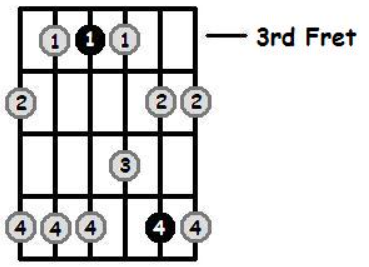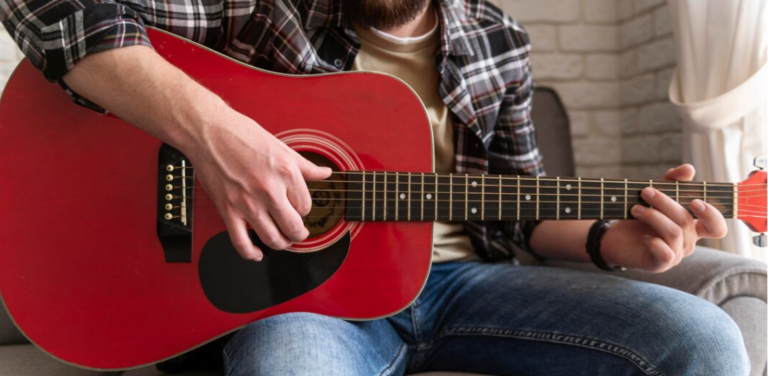Learn To Play The Amazing F Minor Pentatonic Scale

The F Minor Pentatonic scale is a foundational element in the arsenal of guitarists across genres—from blues and rock to jazz and beyond. This blog post will guide you through understanding and mastering this versatile scale.
What is the F Minor Pentatonic Scale?
The Pentatonic scale, meaning “five notes,” is a musical scale with five notes per octave, which in the case of the F Minor Pentatonic, are derived from the natural minor scale. The notes of the F Minor Pentatonic Scale are:
F – Ab – Bb – C – Eb
These notes provide a slightly moody, yet powerful melodic base that is simpler to handle due to its reduced number of notes.
Fretboard Position
To play the F Minor Pentatonic Scale on the guitar, you can start with the following fretboard position:
1st Position

- 6th string (E string):
- Place your index finger on the 1st fret and play the F note.
- Place your pinky on the 4th fret and play the Ab note.
- 5th string (A string):
- Use your index finger to play the Bb note on the 1st fret.
- Use your ring finger to play the C note on the 3rd fret.
- 4th string (D string):
- Use your index finger to play the Eb note on the 1st fret.
- Use your ring finger to play the F note on the 3rd fret.
- 3rd string (G string):
- Use your index finger to play the Ab note on the 1st fret.
- Use your ring finger to play the Bb note on the 3rd fret.
- 2nd string (B string):
- Use your index finger to play the C note on the 1st fret.
- Use your pinky to play the Eb note on the 4th fret.
- 1st string (high E string):
- Use your index finger to play the F note on the 1st fret.
- Use your pinky to play the Ab note on the 4th fret.
3rd Position

- 6th string (E string):
- Place your index finger on the 3rd fret to play the G note.
- Use your pinky to play the Bb note on the 6th fret.
- 5th string (A string):
- Place your index finger on the 3rd fret to play the C note.
- Use your pinky to play the Eb note on the 6th fret.
- 4th string (D string):
- Use your index finger to play the F note on the 3rd fret.
- Use your pinky to play the Ab note on the 6th fret.
- 3rd string (G string):
- Place your index finger on the 3rd fret to play the Bb note.
- Use your pinky to play the C note on the 6th fret.
- 2nd string (B string):
- Place your index finger on the 3rd fret to play the Eb note.
- Use your pinky to play the F note on the 6th fret.
- 1st string (high E string):
- Use your index finger to play the G note on the 3rd fret.
- Use your pinky to play the Bb note on the 6th fret.
5th Position

- 6th string (E string):
- Place your index finger on the 6th fret to play the Bb note.
- 5th string (A string):
- Place your index finger on the 5th fret to play the Db note.
- Use your ring finger on the 8th fret to play the Eb note.
- 4th string (D string):
- Place your index finger on the 5th fret to play the F note.
- Use your ring finger on the 8th fret to play the Ab note.
- 3rd string (G string):
- Place your index finger on the 5th fret to play the Bb note.
- Use your ring finger on the 8th fret to play the Db note.
- 2nd string (B string):
- Place your index finger on the 6th fret to play the Eb note.
- Use your ring finger on the 9th fret to play the F note.
- 1st string (high E string):
- Place your index finger on the 6th fret to play the Bb note.
8th Position

- 6th string (E string):
- Place your index finger on the 8th fret to play the C note.
- Use your pinky on the 11th fret to play the Eb note.
- 5th string (A string):
- Place your index finger on the 8th fret to play the F note.
- Use your pinky on the 11th fret to play the Ab note.
- 4th string (D string):
- Place your index finger on the 8th fret to play the Bb note.
- Use your ring finger on the 10th fret to play the C note.
- 3rd string (G string):
- Place your index finger on the 8th fret to play the Eb note.
- Use your ring finger on the 10th fret to play the F note.
- 2nd string (B string):
- Place your index finger on the 8th fret to play the Ab note.
- Use your middle finger on the 9th fret to play the Bb note.
- 1st string (high E string):
- Place your index finger on the 8th fret to play the C note.
- Use your pinky on the 11th fret to play the Eb note.
10th Position

- 6th string (E string):
- Place your pinky on the 13th fret to play the F note.
- 5th string (A string):
- Place your pinky on the 13th fret to play the Ab note.
- 4th string (D string):
- Place your pinky on the 13th fret to play the Bb note.
- 3rd string (G string):
- Place your middle finger on the 12th fret to play the C note.
- Place your index finger on the 10th fret to play the Eb note.
- 2nd string (B string):
- Place your middle finger on the 11th fret to play the F note.
- Place your index finger on the 10th fret to play the Ab note.
- 1st string (high E string):
- Place your middle finger on the 11th fret to play the Bb note.
- Place your index finger on the 10th fret to play the C note.
Practical Applications
Improvisation
The F Minor Pentatonic is perfect for improvising solos. It’s often used in blues and rock to create expressive and memorable solos. Practice bending, vibrato, and slides within this scale to add emotion to your playing.
Composing
Many popular songs use the minor pentatonic scale for their riffs and melodies. Experiment with different rhythmic patterns and intervals within the scale to craft your own tunes.
Exercises to Master the Scale
- Ascending and Descending: Play the scale ascending from the lowest note to the highest, and then descending. Focus on even tempo and clean note articulation.
- Sequences: Play the scale in sequences, such as playing every other note (skipping one note each time), to build finger independence and control.
- Jam Tracks: Use backing tracks in F minor to practice improvising with the scale. This will help you understand how the scale fits within different chord progressions.
The F Minor Pentatonic Scale is a gateway to expressive guitar playing. Its simplicity allows for ease in learning, while its musical versatility provides a broad canvas for creativity. Practice regularly and incorporate the scale into different musical contexts to fully exploit its potential.
If you’re interested in learning an instrument, at Real Brave, we offer an incredible experience like no other place in music lessons for kids and adults by guiding them from the beginning stages of getting to know an instrument all the way through performing for family and friends on stage. Our instructors come from all over the world, bringing extensive experience on a wide range of instruments. Click below and book a free lesson with us!
Author: Daniel Powers Jr, the founder of Real Brave™, serves as the chief inspiration to thousands of students in the Real Brave music instruction program. He’s also the visionary behind PracticePad™, an online platform for live one-on-one online music lessons, lesson tracking, and scheduling. Beyond his entrepreneurial pursuits, Daniel leads a non-profit organization that provides formerly homeless children with access to music education, making a profound impact on their lives. His unwavering dedication to music, innovation, and education continues to inspire individuals to reach their fullest potential while creating positive change in communities. Follow Real Brave on all the socials:
youtube.com/@realbraveinc
twitter.com/realbraveinc
https://www.tiktok.com/@realbraveinc
instagram.com/realbraveaudio
facebook.com/realbraveinc






